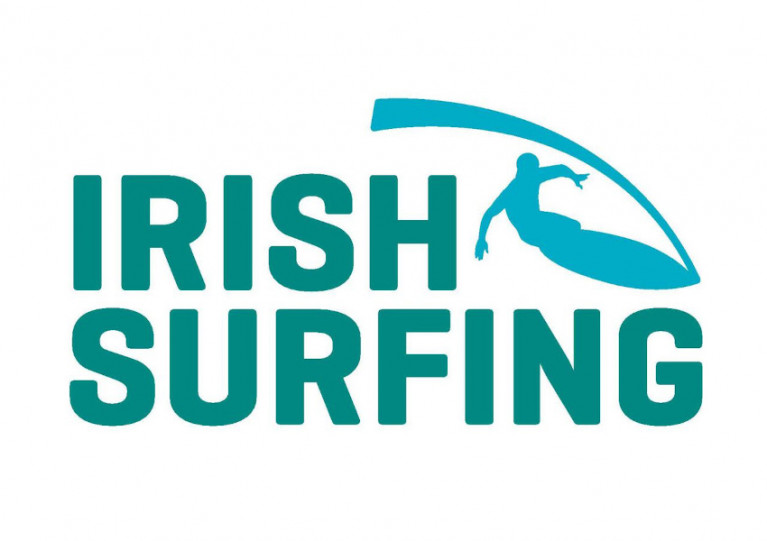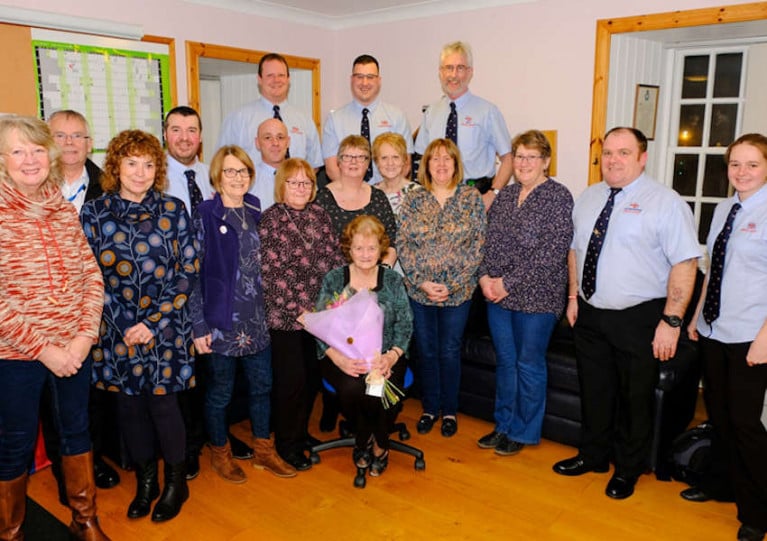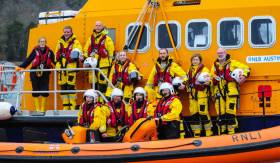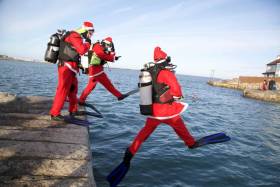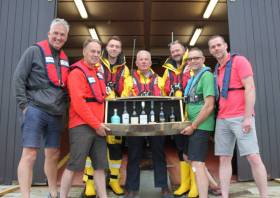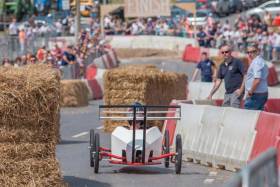Displaying items by tag: Fundraising
Irish Surfing Launches Crowdfunding Campaign For Live Scoring Display
Irish Surfing has launched a crowdfunding campaign to purchase a live scoring system for competitive events.
The national governing body for surfing in Ireland is already nearly a third of the way towards the €6,000 goal for the priority display system.
Junior and senior competitors, spectators and race officials alike would benefit from this effort to professionalise its delivery of events, Irish Surfing says.
All funds raised will be administered through Irish Surfing’s Sligo base with a view to purchasing and training staff with using the system over the coming months.
Lerwick Lifeboat Guild Fundraising Volunteer Steps Down After 38 Years
Bella Irvine has retired from the Lerwick Ladies Lifeboat Guild after 38 years service, since first volunteering for the Shetland Islands RNLI unit in 1982.
At a gathering at RNLI Lerwick lifeboat station to mark the occasion last Tuesday evening (4 February), members of the guild and current lifeboat crew members paid tribute to Bella’s contribution on the committee.
After her first 10 years, Bella was then treasurer for 23 years, from 1992 until 2015. Since then, she has continued to support fundraising events and activities, including volunteering in the RNLI Lerwick shop.
In recognition of her long service, Bella received a RNLI Gold Badge and Bar in 2016.
The guild raises funds for the RNLI towards the operational costs of the Lerwick lifeboat in Scotland's far nothern isles, which relies entirely on public donations.
‘She’s one in a million and will always be welcome in our shop, where she will always find the kettle on’
Throughout the year, the guild organises many events, including the popular Lifeboat Open Day in midsummer and the Lifeboat Ball later in the year. Committee members also attend country shows during the summer months to generate income and to raise the profile of the RNLI.
In 2019, the Lerwick Lifeboat Guild, including funds raised by the men’s committee, raised a total of over £44,000.
Rhoda Watt, joint chair of the Lerwick Ladies Lifeboat Guild and current treasurer, said: “Bella has been absolutely dedicated beyond measure and will be missed on our committee. She’s one in a million and will always be welcome in our shop, where she will always find the kettle on.”
Malcolm Craigie, RNLI Lerwick lifeboat operations manager, said: “The RNLI relies on dedicated fundraisers across the country to provide equipment and training for our volunteer crews, so that we’re ready to respond 24 hours a day.
“On behalf of the lifeboat crew, we’re hugely grateful to Bella for everything she has done for the Lerwick Lifeboat Guild over the last 38 years.”
Table Quiz In Dublin Will Raise Funds For Underwater Search Unit
The Irish Underwater Search and Recovery Unit is one of two charities that will be supported in an upcoming table quiz and raffle in Dublin city centre.
Richard Cruise, Conor Galvin and David Cotter are organising the event to raise funds for the IUSRU as well as Óglaigh Náisiúnta na hÉireann, the organisation of national ex-service personnel — two charities who do great work in assisting others in times of distress.
Entry is €40 per teams of four and all are welcome to join the quiz at the Teachers’ Club on 36 Parnell Square West on Thursday 2 April, starting at 7.30pm.

Cork Lifeboat Crews To Share Their Lifesaving Stories This Wednesday On RTÉ’s Nationwide
Volunteer lifeboat crews from Crosshaven and Ballycotton RNLI in Cork will share their own stories of how they got involved with the lifesaving charity on TV for RTÉ One’s Nationwide this coming Wednesday 18 December.
And the two stations will also carry out a joint exercise to recover an unconscious casualty from the water, as they appeal to the public to support the RNLI’s ‘Perfect Storm’ fundraising campaign.
In Crosshaven, local business owners Aoife Dinan, of Rejuvenate beauty salon, and Denis Cronin of the popular Cronin’s Bar both volunteer for the Cork Harbour village’s lifeboat crew.
Denis was a keen surfer before he volunteered for the lifeboat and now answers the pager by jumping on his pushbike and heading to the station a couple of minutes away.
Aoife and her partner lost a close friend to drowning and she is now an active member of the lifeboat crew, often running from her business to make callouts at the station.
Best friends Molly Murphy and Caoimhe Foster joined the lifeboat together when they were in fifth year in school. They speak about what it was like to rush out of the classroom and down to the lifeboat station for a callout and to leave their schoolmates behind.
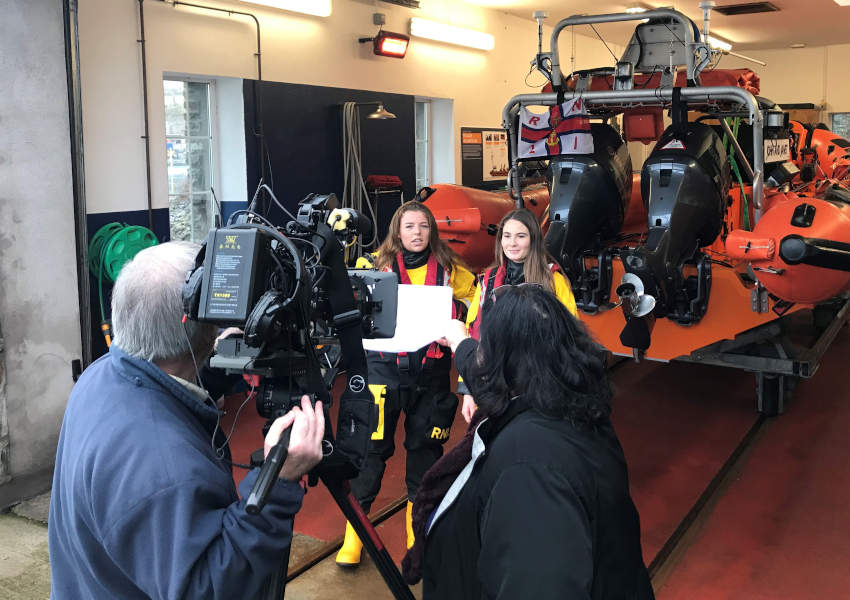 Crosshaven RNLI volunteers and best friends Molly and Caoimhe face the RTÉ Nationwide camera | Photo: RNLI/Niamh Stephenson
Crosshaven RNLI volunteers and best friends Molly and Caoimhe face the RTÉ Nationwide camera | Photo: RNLI/Niamh Stephenson
Ballycotton RNLI crew member Alan Cott lost his brother Glynn when the Maggie B sank in 2006. He is very proud of his involvement with the lifeboat and is honouring the memory of his brother in the work he does to save lives at sea.
Speaking about the programme and the launch of the Perfect Storm appeal by the RNLI, area lifesaving manager Brian O’Driscoll said: “Our lifeboat crew are what is best in the RNLI. These men and women give up their time to train and launch lifeboats in all weathers and to all types of situations.
“Our thanks to the Nationwide team for visiting two of our Cork lifeboat stations and speaking to our volunteer lifeboat crew about why they do it and what they get out of it.
“Many people don’t realise that the RNLI is a charity and we depend on the generosity of the public to continue with our work saving lives at sea.
“Aoife, Denis, Alan, Molly and Caoimhe give their time and their passion to the RNLI and in return they get the training, skills and equipment to be able to help those in trouble at sea. We are very grateful for the support of the public and we don’t take it for granted.”
To support the RNLI’s Perfect Storm appeal this Christmas, helping to ensure the charity’s brave volunteers can continue saving lives at sea, visit RNLI.org/ThePerfectStorm
Santa Scuba Dive Takes The Plunge For Lifeboats In Sandycove This Weekend
Tomorrow at noon (Sunday 15 December) Scuba divers dressed in Santa suits will be ready to dive into the sea water off Sandycove for the annual Santa Scuba Dive.
This unique Christmas event has raised over €12,000 for the RNLI since it was started in 2014 by Karen Kenny of the Dublin University Sub Aqua Club.
Divers will enter the water at 1pm, and spectators will also see the local D-class lifeboat and Howth Coast Guard RIB and a flyby from the Dublin-based coastguard helicopter, weather and operations permitting.
For more see the event page on Facebook and the fundraising page on JustGiving.
Sailors Do A ‘Whiskey Run’ For Portrush & Islay Lifeboats
A group of seven men from the North Coast hatched a novel way to carry out some fundraising for the Portrush and Islay RNLI volunteer lifeboat crews recently.
As a group of keen sailors and avid supporters of the RNLI and the Scottish islands, they wanted to marry the two passions together and have some fun along the way.
The team decided to row to Islay to recreate a journey made over the generations using only manpower to raise money for the lifeboats.
The team was fortunate to be able to borrow ‘Home to Portrush’, the famous local boat that had crossed the Atlantic in record time in February 2018. Their challenge was to visit all the coastal distilleries on Islay and collect some whiskey from each one.
Ashley Moore, one of the crew, said: “We left from Ballintoy at 3am in idyllic conditions in order to reach Port Ellen and not be swept around the headland as the tide turned.
“Thankfully we made it in nine-and-a-half hours and over the next three days went on to visit Laphroaig, Lagavulin, Ardbeg, Coal Ila, Bunnahabhain, Bowmore and Bruichladdich, collecting whisky bottles along the way.
“We were blown away by the warmth of the welcome across Islay and the distilleries — we were given many offers of food and accommodation and each distillery presented us with a bottle of whisky and a stave from one of their barrels to allow us to create the Islay Sea Collection.”
On returning home, team member and local architect Graeme Montgomery set out to design and create a unique cask to display the bottles of whisky, with the source of each stave marked.
‘This is a really exciting and novel way to raise funds for the two stations’
Bids are now being accepted until Sunday 17 November at just-whisky.co.uk for this ‘one of a kind’ whisky collection — and sponsors, including Coleraine software company Spatialest, have already pledged £2,000.
To register to bid you will have to pay £5 but this will be donated to RNLI. During registration, under box number 2 will see a box asking you to leave a message — in this box you must type in RNLI BID to ensure that the £5 registration fee comes to Portrush and Islay RNLI.
Portrush lifeboat operations manager Keith Gilmore said: “This is a really exciting and novel way to raise funds for the two stations. We often have to work with Islay, and this is a great way to work with one of our neighbours and local supporters to raise funds for the RNLI.”
Ashley Moore added: “This was a really fun way to see the Scottish islands in a different way while helping to raise funds to support the work of the RNLI – and to enjoy some exceptional whisky!
“As sea lovers each one of our team never takes for granted the exceptional and brave work of the lifeboat crews and we are so grateful to know they are there whenever needed.”
Hero’s Welcome In Ballycotton For Eoghan Quinn Despite Lack Of Wind Foiling His Kitesurf Challenge
There was some disappointment for kitesurfer Eoghan Quinn as his attempt to ride the waves from France to Ireland yesterday (Sunday 30 June) ended prematurely when the wind dropped off Cornwall, just short of the halfway point.
But the 31-year-old, who has Type 1 diabetes and was taking on the challenge to raise funds for and awareness of Diabetes Ireland, arrived in Ballycotton on his support boat yesterday evening to a hero’s welcome.
“A lot of planning went into this but mother nature is the one thing we cannot control, but we achieved what we set out to do which was to raise awareness,” he told RTÉ News.
The route from France to Ireland through the Celtic Sea — dubbed the ‘Kitesurf Road’ — has never before been completed by kite and board.
Quinn had hoped to beat the Cherbourg-Rosslare ferry by crossing in under 16 hours.
Ballycotton welcomes @EoghanQuinn1 pic.twitter.com/lwoL2KWw9U
— Ballycotton (@BallycottonIRE) June 30, 2019
A Waterford man with Type 1 diabetes is currently kitesurfing over 275 miles of open water from France to Ireland today (Sunday 30 June) in aid of a charity supporting people with the disease.
Eoghan Quinn is attempting to race the Cherbourg-Rosslare ferry and cross the waves of the Celtic Sea in under 16 hours to raise funds for of Diabetes Ireland. (See his EverydayHero fundraising page HERE.)
It’s a route that’s never before been completed by a kitesurfer — and Eoghan will have the added complication of managing his blood glucose and insulin levels along the way.
But such challenges are nothing new to the 31-year-old kitesurfing champion, who has previously completed a 6,000km cycle to Gaza and a 1,000km ride from Melbourne to Sydney.
Diabetes Ireland has more on the story, and you can track Eoghan’s progress HERE.
Guy O’Leary’s challenge to swim a mile each day during the month of May has so far raised a whopping €70,000 for Cancer Research UK.
As previously reported on Afloat.ie, Guy — son of Dun Laoghaire Marina developer and local sailing stalwart Michael O’Leary — was diagnosed with cancer after a routine check-up in November 2017 at the age of 34.
Following a lengthy period of treatment, he decided he needed to do something to pay back the medical staff and researchers — not to mention family and friends — whose support means he’s still here today.
That’s where his idea to swim a mile a day in the month of May came about.
Guy began his MileADayInMay! challenge on Wednesday 1 May with his wife Aoife, and as he continued was joined each day by “someone who helped me through the rough times”.
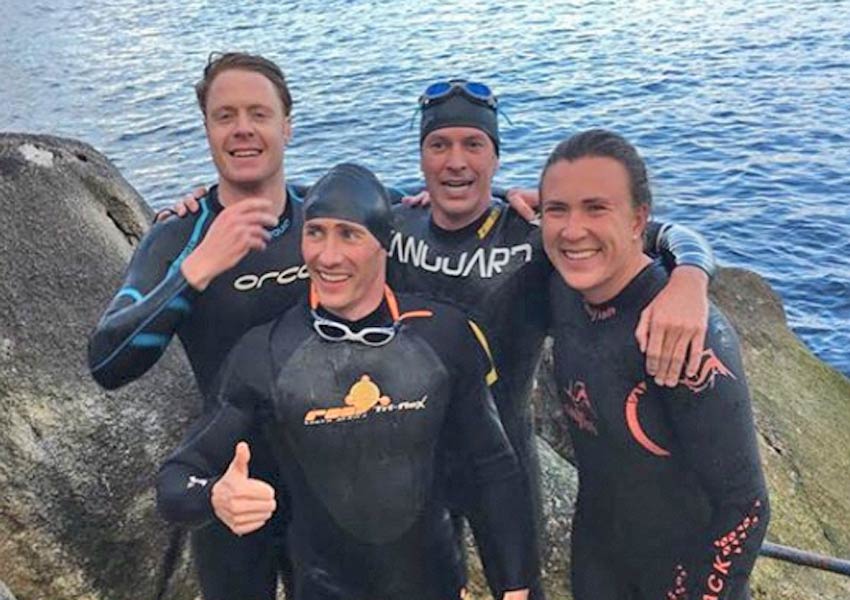 Guy (left) with Annalise Murphy and friends on Day 27 of his challenge | Guy O’Leary/Instagram
Guy (left) with Annalise Murphy and friends on Day 27 of his challenge | Guy O’Leary/Instagram
These included names familiar to Afloat.ie readers such as Annalise Murphy, the Goodbodys and Kinsale’s Sam Hunt — as well as others with a closer connection to the reason for his challenge such as fellow cancer patient Jim Right Now, and his own oncology nurse Lorna Lee.
Over the month he and his swimming companions braved the chilly waters of Killiney Bay, the more comfortable environs of the Trinity College pool, and even sunny Brockwell Lido and the Olympic pool in London.
And as promised, his final mile started outside Dun Laoghaire Harbour, finishing at the Royal Irish Yacht Club slipway.
“This has been an incredible challenge for me,” he said after his last swim of the month. “Thanks to the 45 swimmers who completed a mile with me and for all the donations so far.”
As of today the total raised stands at are than £62,000 — and Guy’s fundraising campaign is still active for anyone who wants to contribute.
Bundoran Lifeboat Crew Gears Up For Soapbox Sunday
Final preparations are being made ahead of this weekend’s Bundoran RNLI Soapbox Race which takes place this Sunday 2 June at Astoria Road.
Now in its eighth year, the event is organised and hosted by the volunteer crew of the Bundoran RNLI lifeboat and is a major fundraiser for the charity.
The event is expected to attract as many as 2,000 soapbox enthusiasts and their supporters with race winning between 1pm and 4pm, weather permitting.
The prize up for grabs is the highly coveted Perpetual Cup and 12 months of bragging rights.
And the ever-popular €1,000 ball race will also take place directly after the soapbox final has been run, with balls on sale at just €5 from lunchtime on the day.
Event director Cormac McGurren says that the crew is looking forward to the day.
“The soapbox race is always the talk of the station for the weeks and months before it happens. It’s a fun family day out with lots of thrills and spills expected.
“We would like to thank in advance all of our sponsors, prize donors and local volunteers who are helping to run the event and also to sell the balls.”
Those wishing to race a soapbox on the day are encouraged to register online, though last-minute registrations on the day will be accepted.
There will be a number of traffic restrictions in place this Sunday to facilitate the race. Astoria Road will be closed from 8am till 7pm on Sunday at the junction with Main Street.
Traffic for Waterworld, Bundoran Adventure Park and Ozanam House should use Promenade Road and Atlantic Way. Traffic for Main Beach, Great Northern Hotel and Bundoran Golf Club should use Sea Road. Main beach car park will be open for parking as normal (with access via Sea Road).


























